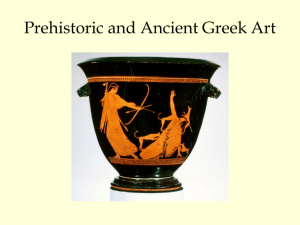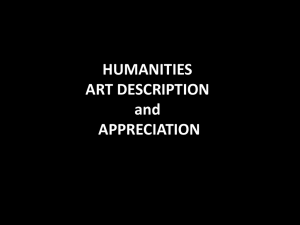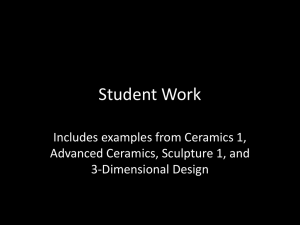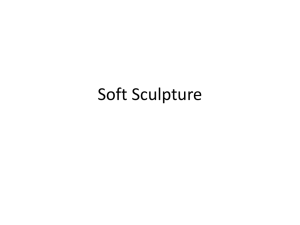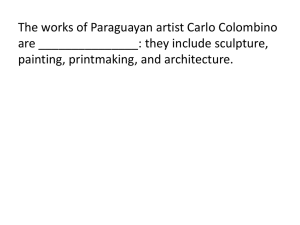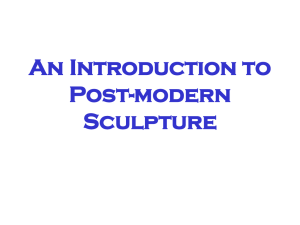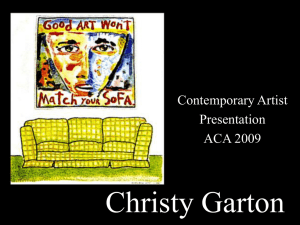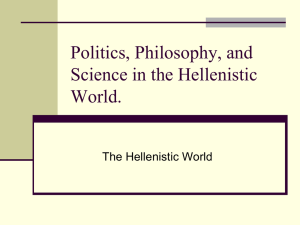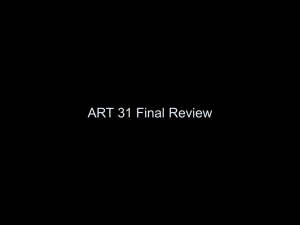SCULPTURE
advertisement
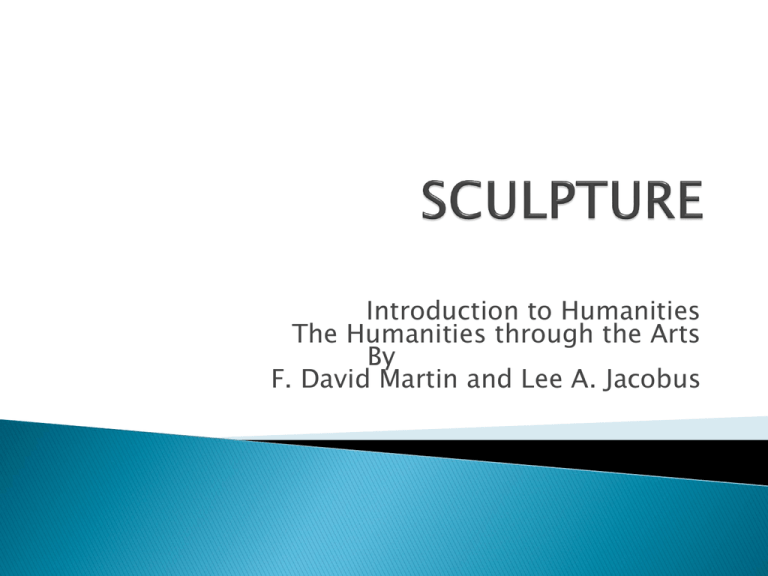
Introduction to Humanities The Humanities through the Arts By F. David Martin and Lee A. Jacobus Sculpture along with painting and architecture is classified as one of the visual arts. This classification suggest that the eye is the chief sense organ involved in our participation with sculpture. Yet...some kinds of sculpture invite us to explore and caress them with our hands, even to pick them up if not too large or heavy. Tactile sense pulls us to touch a sculpture. Sculpture engages our senses differently than painting does. This is because sculpture occupies space as a three-dimensional mass, whereas painting is essentially a two-dimensional surface that can only “represent” three dimensionality. Painting can suggest density but sculpture is dense. Generally no clear separation is made in experience between the faculties of sight and touch. The sensa of touch, are normally joined with other sensa – visual, aural, oral, and olfactory. Even if only one kind of sensum initiates a perception, a chain reaction triggers off other sensations, either by sensory and motor connections or by memory associations. Rothko’s Earth Green (figure 4-1) and Arp’s Growth (figure 5-1) both works are abstract, for neither has as its primary subject matter specific objects or events. Arp’s sculpture has something to do with growth as confirmed by the title. But is it human, animal or vegetable growth? Rothko has abstracted sensa, especially colors, from objects or things.. Abstract painters generally emphasize the surfaces of sensa, as in Earth Greens. The interest is in the vast ranges of color qualities and the play of light to bring ut the textural nuances. Where as abstract painters are shepherds of surface sensa, abstract sculptors are shepherds of depth sensa. We usually think of sculpture as dense and projecting out into space. Yet in the Egyptian work there is no projection whatsoever. Carving grooves of various depths into the surface plane of the stone to outline each object, is called sunken relief. There are clearly noticeable projections out into space There are no background starting points that function as the bases for the planar organizations. The surface planes of the panels function as the basic organizing planes: hence the expression “surface relief.” Relief sculpture projects from a background plane such as a wall or column. Low-relief sculpture projects relatively slightly from its background plane, and so its depth dimension is very limited. Medium and high –relief sculpture project further from their backgrounds, And so their depth dimensions are expanded. Relief sculpture allows its materials to stand out from a background plane. Thus relief sculpture in at least one way reveals its materials simply by showing us directly-their surface and something of their depth. High relief stands out from the wall. Michelangelo’s Pieta Intended it to be placed in a niche so it would be seen from the front. It is a transition piece between high-relief sculpture, such as the Dancing Asparas and unqualified sculpture in the round, such as growth. Architecture is the art of separating inner from outer space in such a way that the inner space can be used for practical purposes. With Sculpture there is no inner space. Fig 5-9 is clearly sculpture because there is no inner space. The space around a sculpture is sensory rather than empty. Despite its invisibility, sensory space - like the wind - is felt. Sculptures such as Growth are like magnets from which radiating vectors flow. As we focus on such sculptures we find ourselves being drawn in and around by these invisible but perceptible radiating forces. Sculptures generally are more or less a center – the place of most importance which organizes the places around it – of actual three-dimensional space: “more in the case of sculpture in the round, “less” in the case of low relief. No object is more important to us than our body, and it is always “with” us. Sculpture in the round often evokes our inward sensations… When we participate with sculpture such as Aphrodite, we find some thing of our bodily selves confronting us. Art is always a transformation of reality, never a duplication. Thus the absence of head and arms in the Aphrodite does not shock us as it would if we were confronting a real woman. Nor does their absence ruin our perception of the beauty of this statue. Even before the damage, the work was only a partial image of a female. The Aphrodite is substantial because the female shape, texture, grace, sensuality, sexuality, and beauty are interpreted by form. Sculpture in relief and in the round generally is made either by modeling or carving. Space sculpture, such as Calder’s Gates of Spoleto fig 5-16 generally is made by assembling preformed pieces of material. The modeler starts with some plastic or malleable material such as clay, wax, or plaster and “builds” the sculpture. If the design is complex or involves long or thin extensions, the modeler probably will have to use and internal wooden or metal support (armature) that functions something like a skeleton. The sculptor in bronze begins with clay or some similar material and builds up a model to a more or less high degree of finish. Space sculpture never completely loses its ties to the materiality of its materials. The materials of Antennae with Red and Blue Dots and The Gates of Spoleto (fig 515 & 5-16) despite their thinness, appear heavy. The Spiral Theme fig 5-17 planes of plastic divide space with multidirectional movement, no visual barriers develop. Developments in sculpture are emerging and changing so quickly that no attempt can be made here even to begin to classify them. These developments fall into the species of low, medium, and high relief, sculpture in the round, space sculpture, earth sculpture, and some hybrids of these. There is fairly pervasive respect for the material used in sculpture. In contemporary sculpture respect for materials has come back and is called “truth to materials.” The Maternity Group fig 5-21 is notable in its respect for materials. Explicit social protest is part of the subject matter of all these works by Trova, Segal, and Giacometti, Wheel Man fig 5-22 protest directed at technology. The Bus Driver fig 5-23 is “environmental sculpture.” There is no center in this city square fig 524 or any exit, nor can we imagine any communication among these citizens. Sculpture today far more than painting can take advantage of some of the most sophisticated advances of technology. Many sculptors today interpret the positive rather than the negative aspects of technology. This respect for technology is expressed by; 1) truth to its materials or 2) care for its products or 3) showing forth it methodology. Some avant-garde sculptors are interested not so much in the materials and products of technology but rather in the machine and its powers: their works are known as “machine sculpture” Tinguely is dedicated to humanizing the machine (Homage to New York) fig 5-30. Another avant-garde sculpture “earth sculpture” – goes so far as to make the earth itself the medium, site, and the subject matter. Fig 5-33 The proper spatial selection becomes absolutely essential, for the earth usually must be taken where it is found. Traced in plains, meadows, sand, snow, ect., called “form site” Sculpture in open spaces is by no means a new idea, but the modern practice of placing monumental steel constructions in open natural settings is owning to David Smith’s (Cubi X) fig 5-25 City on the High Mountain fig 5-34 permits the viewer to walk completely around the work, observing the play of light and shadow. Sculpture has traditionally shared its location with major buildings, sometimes acting as decoration on the building, as in many churches, or acting as a center point of interest. Many public sculptures commemorate war or other important events. One of the most successful (fig. 5-38) public sculptures by Maya Ying Lin (Vietnam Veteran Memorial) in Washington, D.C..
